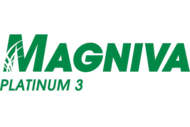Growing corn for feed can be a costly operation, but — if managed and treated correctly — the silage produced can easily replace more expensive purchased feeds. In fact, producers who make good quality silage from their forages tend to be the most profitable! Making good silage requires good management from the field to the bunker. Using a challenge-specific inoculant such as MAGNIVA Platinum is essential but so are simple management practices that can make all the difference when ensiling corn.
Before harvest:
- Prepare the storage area (clean it)
- Prepare the harvest equipment (sharpen knives)
- Clean the applicator equipment
- Check the field frequently to define the optimal time to harvest (optimal maturity stage for corn is 30-35% DM)
- Check the crop condition (drought, hail damage, fungi growth, etc.)
- Make sure the correct MAGNIVA Platinum inoculant is ordered and delivered to deal with the challenges the corn may present
During harvest:
- Harvest management
- Cutting height: 25 cm, depending on DM and quality
- Chop length: 0.8-2 cm varying with shredlage and DM (the higher the DM level, the shorter the cutting length)
- Take care to not incorporate soil, this can lead to a poor fermentation and lower quality silage
Corn cracking:
-
- Will influence energy availability in the rumen
- The higher the DM, the more important it is to adequately process the grain
- 70% of all grain should be under 4.75 mm
- How to measure corn cracking efficiency in the field:
In 1 kg of silage, no more than 3-4 kernels should be visibly not broken or half broken. If there are more than this, the starch will not be as available in the rumen.
Bunker/silo management – compaction:
-
- Fill the bunker in smaller layers: Horizontal layers < 15cm
- Roll the corn until an optimal density of 240 kg DM/m3 is achieved to calculate density
- The optimal tractor weight to pack the silo:
- Weight of tractor (kg) = speed of filling (t Dry Matter/hour) x 400
- Minimum: (Total mass of forage entering in the silo (t FM)/hour) / 4
- Sealing the bunker/silo:
- Seal as fast as possible and try not to leave open overnight
- Use a good quality plastic and, if possible, an oxygen barrier film
- Cover the side walls
- Use silo bags on top on the plastic and net, if needed
Choose the right silage inoculant depending on your territory:
- Define the best product to use in your territory with your local or global technical support team
- The right silage inoculant targeting the right challenge will:
- Drive a good initial fermentation
- Keep your silage cool and stable after opening
- Reduce DM losses, energy losses and nutrient value losses
- Reduce spoilage from yeasts and molds






